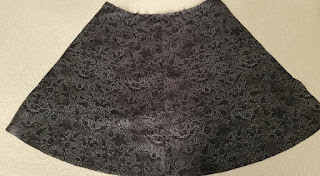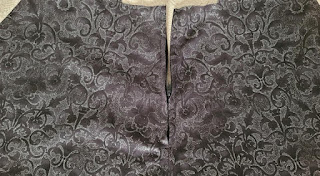It was the season of Halloween when Gwen's Shenanigans proposed #gunnesaxoween - a costumers collaboration creating a Gunne Sax outfit with a Halloween impression.
I joined in the fun using a vintage Gunne Sax licensed pattern by Simplicity and created this:
And then I wrote on my blog and created a video sharing a bit of the history of Gunne Sax and the process of sewing my #gunnesaxoween outfit.
As the holiday season approached Gwen's Shenanigan's proposed that we extend our Gunne Sax fun using the hashtag #gunnesaxmas which will be inclusive of all holidays and traditions and inspired fabrics.
Of course since I had so much fun creating for Halloween, I'm ready to create for the Holidays and want to again use the pattern I used, Simplicity 5491 Gunne Sax licensed.
I had also joined in a collaboration for #holidayapron and that blog post and video were published earlier. The fabric I'm using for this project is called Cardinals on White Ice with Silver Metallic from the Joyful Traditions Collection by Hoffman. I purchased enough for the holiday apron and parts of the jacket and skirt.
For the other parts of the jacket and skirt I purchased a coordinating Hoffman fabric called Joyful Traditions Ornate Damask Scroll in Black and Silver.

Both of those fabrics are cotton. The jacket requires a bias edging as did the apron. After considering many options I always came back to the one that I loved immediately when I saw it (isn't that often the case?) and it was a red with black buffalo plaid.
As also often happens in creating an historical or, in this case, vintage garment, there is research and learning that naturally occurs. This project was no different as I began to wonder about the history of buffalo plaid.
As you can see, it is a check with large blocks formed by the intersection of two colors. According to the Scottish Tartans Authority, it is, in fact, the Rob Roy Tartan.
It was introduced to North America by a descendent of Roy Roy, Jock McCluskey. As an Indian trader, McClusky championed the Indian's cause. His reasons were personal seeing their plight as similar to his own family clan's descent from nobility to hunted criminals.
Eventually, it seems, the plaid made its way to the Woolrich Woolen Mills where, in the northeast in 1850, the company began producing shirts in the red and black. The tale goes that the name "Buffalo Plaid" comes from the fact that the mill's designer at the time owned a herd of buffalo.
I've purchased enough of the buffalo plaid for the bias edging and the lining of the jacket and proceed to cut enough bias strips for both this and the apron project.
The Skirt
The skirt pieces consist of a front in two parts, a back in two parts, a waistband with interfacing, 4 pocket pieces and a ruffle. I have a zipper and pretty velvet and ribbon embroidered button.
The center front seam is sewn.
The center back seam is sewn and the zipper added.
The pocket pieces are sewn to both edges of the front and back skirt sections.
The fusible interfacing is applied to the waistband and the lower edge seam allowance turned under.
The unfolded edge is sewn to the skirt right sides together. The ends of the waistband are folded in half, stitched together, and the seam allowance is clipped.
The ends are turned right side out and the waistband folded edge turned to cover the long seam just sewn and handstitched in place. A snap is sewn on the waistband and the velvet button sewn to cover the snap stitches.
My plan for the jacket and skirt was to combine the cotton fabrics to make best use of them including what I needed for the apron. I had determined I had enough of the cardinal fabric for the ruffle if I used the dark fabric for the sleeves of the jacket. I tested several options of lace and plaid bias on the skirt by pinning things together and finally decided I liked this treatment of bias with lace on the lower edge of the upper skirt and on the lower edge of the ruffle. And I have enough lace for the 80 inches of upper skirt and 120 inches of ruffle. Yay!!
With the embellishment decision made I add the bias plaid and lace to the lower edge of the skirt.
The ruffle was cut from the 42" wide fabric from selvedge to selvedge and 12" wide.
The ruffle pieces are sewn into a continuous loop. The bias strips are also sewn together. The bias is sewn to the lower edge and the lace added. Two gathering threads are sewn at the top of the ruffle.
Pins are placed dividing both the ruffle and the skirt into six even sections for ease and evenness of gathering.
The ruffle is gathered, pinned to the lower edge of the skirt, and sewn in place.
The Jacket
The jacket parts are a back, underarm sides, fronts, sleeves and collar.
Just a double check that I like the fabric layout choices I've made and the bit of buffalo plaid lining peering out from the edge of the cotton fabric gives me an idea!
The idea is to add the bias plaid to the jacket seams as well as around the outside edges and sleeve ends. I sew the bias to the edges of each underarm side and the shoulder seam.
The lower edge of the sleeves has bias and lace added, the sleeve heads pleated and basted according to the pattern, and the inner seam sewn closed.
The jacket sections are sewn together and now the collar can be added.
The collar interfacing is fused and the lower edge seam allowance turned under. The inside collar is sewn to the jacket. Then the outside collar is sewn to the inside collar close to the edges and topstitched to the jacket to cover the inside collar seam.
The sleeves are set, pinned, and sewn.
The Beret
I've recently started some research into 1930s fashion in preparation for an adventure in 2022. Details in the spring! I've found some wonderful patterns including this one from the Vintage Pattern Lending Library for a 1935 7-Piece Ensemble from a vintage Weldon's pattern. It includes a pattern for a beret and the illustration in red inspired me to try this pattern for this Holiday Gunne Sax. Nothing like mixing eras!
I've cut two pieces each of the crown tip and the under beret and a single layer of crinoline for each. The crown tip seam is sewn closed and the entire surface sewn in evenly spaced circles. The back seam of the under beret is also sewn closed.
The under beret is sewn to the crown tip and the edge finished with a bias strip.
I added another velvet and ribbon embroidered button to the crown center and two black tassels inspired by the boots.
Before I share the final photos of the finished Gunne Sax, I have several photos of our state bird and one that lives in my yard throughout the year. We feed them black oil sunflower seeds, have a birdbath they often use, and they bring uncomparable beauty and joy to us.
The female is the same silhouette but an earthy brown color and a fun personality.
Wishing you Love and Laughter!
Jeanette
Companion YouTube Video: https://youtu.be/2B5fhXJ6x0U
#gunnesaxmas Playlist: https://www.youtube.com/playlist?list=PLSKRJ01xNNblTAk2Yd_otsHB-xPryBHo9
Historical Sew Monthly - July 2021
Like a Melody - Make something inspired by music.
What the item is: Plaid Beret
How it fits the challenge: Inspiration for me can be simple or complex and sometimes things just link together for no particular reason. That happened here. I was making a vintage outfit for the holiday season. 1970s, so not suitable for the Historical Sew Monthly challenges. As I do every holiday season I had watched Frank Capra's 1946 film "It's A Wonderful Life". In the movie George lassos the moon to the music "Buffalo Gals". I wondered about the song and learned that it was a traditional American song written in 1844. As I was designing my holiday outfit I needed a trim and for no logical reason Buffalo Plaid came to mind as the perfect combination of color and casual comfort for my design. Then I wondered about Buffalo Plaid and found that it is actually the Rob Roy Tartan and the Woolrich Woolen Mills began producing the iconic shirts in 1850. So my brain has connected those historical dots. But how did I come to make a beret? I'm researching 1930s fashion for a project in 2022 and the beret pattern was included in one of my wardrobe patterns and I decided to create the 1930s beret for my 1970s outfit with Buffalo Plaid. I'm still humming "Buffalo Gals"! This may not be completely correct for this challenge but it does explain how my inspiration sometimes works. Often in very strange and mysterious ways!
Material: Buffalo Plaid cotton
Pattern: Vintage Pattern Lending Library 7-Piece Wardrobe
Year: 1930s
Notions: Midweight tulle, velvet button, tassels
How historically accurate is it? Vintage pattern
Hours to complete: 1 hour
First worn: December 2021
Total cost: $4
.jpg)

























































































































Your distinction between sheer fabrics for brightness and heavier drapery for coziness perfectly echoes advice from design experts: “For light‑hungry rooms, always use a sheer curtain… lighter colours reflect more light” while heavier fabrics bring intimacy
ReplyDeletehttps://costumetextileandfashion.blogspot.com/2023/03/mrs-jasleen-dhamija-tribute-by-toolika.html?sc=1750836721498
ReplyDelete